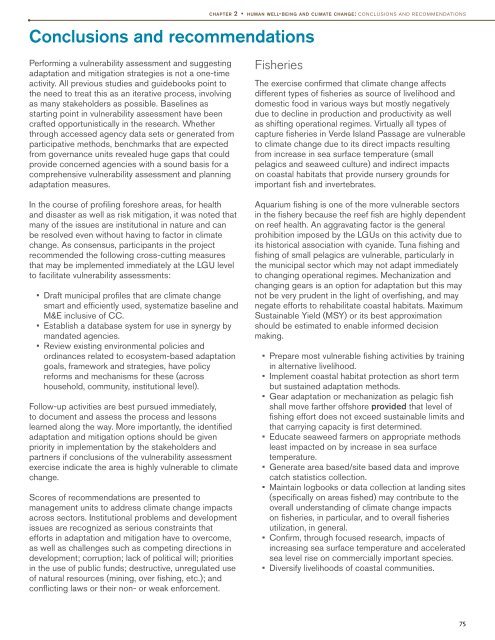of the Verde Island Passage, Philippines - weADAPT
of the Verde Island Passage, Philippines - weADAPT
of the Verde Island Passage, Philippines - weADAPT
You also want an ePaper? Increase the reach of your titles
YUMPU automatically turns print PDFs into web optimized ePapers that Google loves.
Conclusions and recommendations<br />
chapter 2 • human well-being and climate change: conclusions and recommendations<br />
Performing a vulnerability assessment and suggesting<br />
adaptation and mitigation strategies is not a one-time<br />
activity. All previous studies and guidebooks point to<br />
<strong>the</strong> need to treat this as an iterative process, involving<br />
as many stakeholders as possible. Baselines as<br />
starting point in vulnerability assessment have been<br />
crafted opportunistically in <strong>the</strong> research. Whe<strong>the</strong>r<br />
through accessed agency data sets or generated from<br />
participative methods, benchmarks that are expected<br />
from governance units revealed huge gaps that could<br />
provide concerned agencies with a sound basis for a<br />
comprehensive vulnerability assessment and planning<br />
adaptation measures.<br />
In <strong>the</strong> course <strong>of</strong> pr<strong>of</strong>iling foreshore areas, for health<br />
and disaster as well as risk mitigation, it was noted that<br />
many <strong>of</strong> <strong>the</strong> issues are institutional in nature and can<br />
be resolved even without having to factor in climate<br />
change. As consensus, participants in <strong>the</strong> project<br />
recommended <strong>the</strong> following cross-cutting measures<br />
that may be implemented immediately at <strong>the</strong> LGU level<br />
to facilitate vulnerability assessments:<br />
• Draft municipal pr<strong>of</strong>iles that are climate change<br />
smart and efficiently used, systematize baseline and<br />
M&E inclusive <strong>of</strong> CC.<br />
• Establish a database system for use in synergy by<br />
mandated agencies.<br />
• Review existing environmental policies and<br />
ordinances related to ecosystem-based adaptation<br />
goals, framework and strategies, have policy<br />
reforms and mechanisms for <strong>the</strong>se (across<br />
household, community, institutional level).<br />
Follow-up activities are best pursued immediately,<br />
to document and assess <strong>the</strong> process and lessons<br />
learned along <strong>the</strong> way. More importantly, <strong>the</strong> identified<br />
adaptation and mitigation options should be given<br />
priority in implementation by <strong>the</strong> stakeholders and<br />
partners if conclusions <strong>of</strong> <strong>the</strong> vulnerability assessment<br />
exercise indicate <strong>the</strong> area is highly vulnerable to climate<br />
change.<br />
Scores <strong>of</strong> recommendations are presented to<br />
management units to address climate change impacts<br />
across sectors. Institutional problems and development<br />
issues are recognized as serious constraints that<br />
efforts in adaptation and mitigation have to overcome,<br />
as well as challenges such as competing directions in<br />
development; corruption; lack <strong>of</strong> political will; priorities<br />
in <strong>the</strong> use <strong>of</strong> public funds; destructive, unregulated use<br />
<strong>of</strong> natural resources (mining, over fishing, etc.); and<br />
conflicting laws or <strong>the</strong>ir non- or weak enforcement.<br />
Fisheries<br />
The exercise confirmed that climate change affects<br />
different types <strong>of</strong> fisheries as source <strong>of</strong> livelihood and<br />
domestic food in various ways but mostly negatively<br />
due to decline in production and productivity as well<br />
as shifting operational regimes. Virtually all types <strong>of</strong><br />
capture fisheries in <strong>Verde</strong> <strong>Island</strong> <strong>Passage</strong> are vulnerable<br />
to climate change due to its direct impacts resulting<br />
from increase in sea surface temperature (small<br />
pelagics and seaweed culture) and indirect impacts<br />
on coastal habitats that provide nursery grounds for<br />
important fish and invertebrates.<br />
Aquarium fishing is one <strong>of</strong> <strong>the</strong> more vulnerable sectors<br />
in <strong>the</strong> fishery because <strong>the</strong> reef fish are highly dependent<br />
on reef health. An aggravating factor is <strong>the</strong> general<br />
prohibition imposed by <strong>the</strong> LGUs on this activity due to<br />
its historical association with cyanide. Tuna fishing and<br />
fishing <strong>of</strong> small pelagics are vulnerable, particularly in<br />
<strong>the</strong> municipal sector which may not adapt immediately<br />
to changing operational regimes. Mechanization and<br />
changing gears is an option for adaptation but this may<br />
not be very prudent in <strong>the</strong> light <strong>of</strong> overfishing, and may<br />
negate efforts to rehabilitate coastal habitats. Maximum<br />
Sustainable Yield (MSY) or its best approximation<br />
should be estimated to enable informed decision<br />
making.<br />
• Prepare most vulnerable fishing activities by training<br />
in alternative livelihood.<br />
• Implement coastal habitat protection as short term<br />
but sustained adaptation methods.<br />
• Gear adaptation or mechanization as pelagic fish<br />
shall move far<strong>the</strong>r <strong>of</strong>fshore provided that level <strong>of</strong><br />
fishing effort does not exceed sustainable limits and<br />
that carrying capacity is first determined.<br />
• Educate seaweed farmers on appropriate methods<br />
least impacted on by increase in sea surface<br />
temperature.<br />
• Generate area based/site based data and improve<br />
catch statistics collection.<br />
• Maintain logbooks or data collection at landing sites<br />
(specifically on areas fished) may contribute to <strong>the</strong><br />
overall understanding <strong>of</strong> climate change impacts<br />
on fisheries, in particular, and to overall fisheries<br />
utilization, in general.<br />
• Confirm, through focused research, impacts <strong>of</strong><br />
increasing sea surface temperature and accelerated<br />
sea level rise on commercially important species.<br />
• Diversify livelihoods <strong>of</strong> coastal communities.<br />
75
















